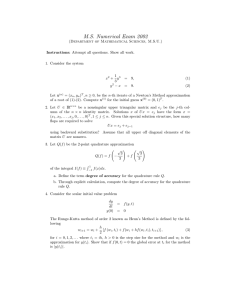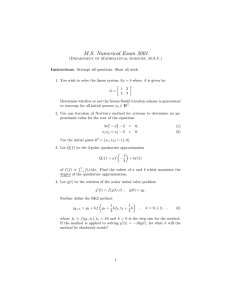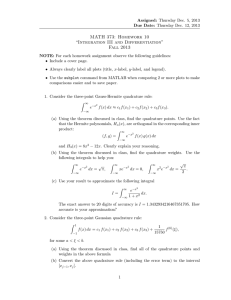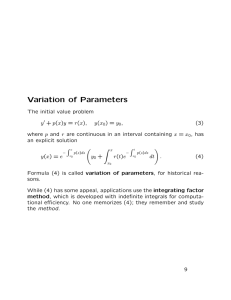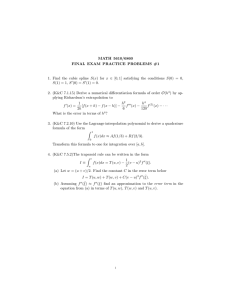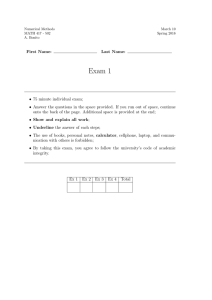ETNA
advertisement
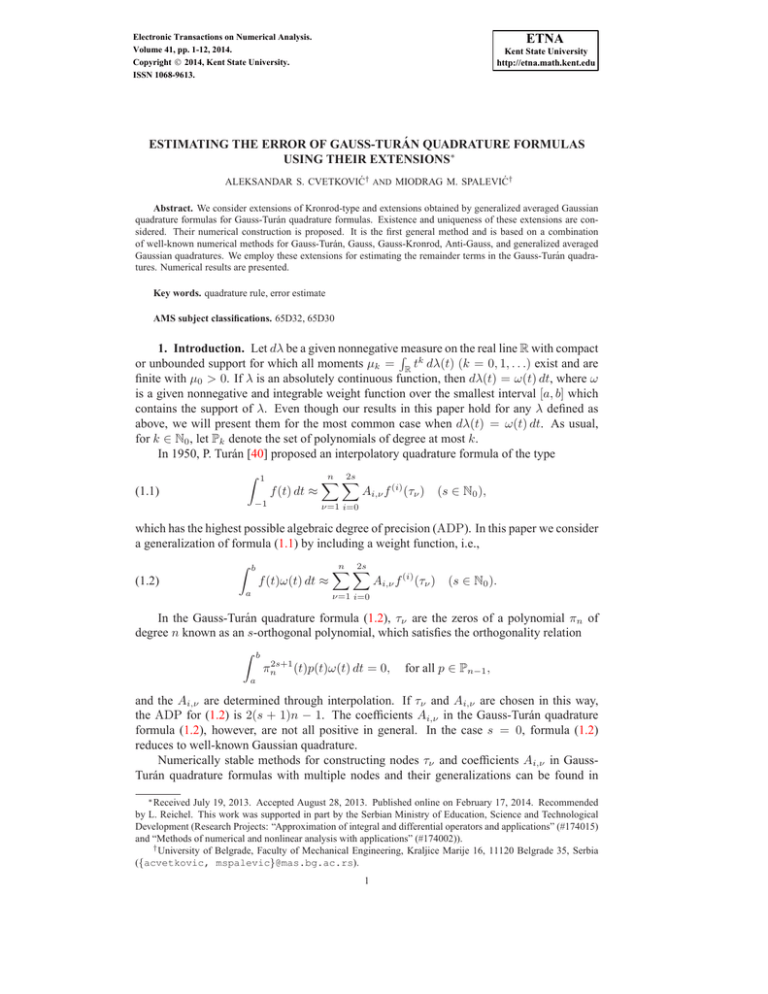
ETNA
Electronic Transactions on Numerical Analysis.
Volume 41, pp. 1-12, 2014.
Copyright 2014, Kent State University.
ISSN 1068-9613.
Kent State University
http://etna.math.kent.edu
ESTIMATING THE ERROR OF GAUSS-TURÁN QUADRATURE FORMULAS
USING THEIR EXTENSIONS∗
ALEKSANDAR S. CVETKOVIƆ AND MIODRAG M. SPALEVIƆ
Abstract. We consider extensions of Kronrod-type and extensions obtained by generalized averaged Gaussian
quadrature formulas for Gauss-Turán quadrature formulas. Existence and uniqueness of these extensions are considered. Their numerical construction is proposed. It is the first general method and is based on a combination
of well-known numerical methods for Gauss-Turán, Gauss, Gauss-Kronrod, Anti-Gauss, and generalized averaged
Gaussian quadratures. We employ these extensions for estimating the remainder terms in the Gauss-Turán quadratures. Numerical results are presented.
Key words. quadrature rule, error estimate
AMS subject classifications. 65D32, 65D30
1. Introduction. Let dλ be a given nonnegative Rmeasure on the real line R with compact
or unbounded support for which all moments µk = R tk dλ(t) (k = 0, 1, . . .) exist and are
finite with µ0 > 0. If λ is an absolutely continuous function, then dλ(t) = ω(t) dt, where ω
is a given nonnegative and integrable weight function over the smallest interval [a, b] which
contains the support of λ. Even though our results in this paper hold for any λ defined as
above, we will present them for the most common case when dλ(t) = ω(t) dt. As usual,
for k ∈ N0 , let Pk denote the set of polynomials of degree at most k.
In 1950, P. Turán [40] proposed an interpolatory quadrature formula of the type
Z
(1.1)
1
f (t) dt ≈
−1
2s
n X
X
Ai,ν f (i) (τν )
(s ∈ N0 ),
ν=1 i=0
which has the highest possible algebraic degree of precision (ADP). In this paper we consider
a generalization of formula (1.1) by including a weight function, i.e.,
(1.2)
Z
b
f (t)ω(t) dt ≈
a
2s
n X
X
Ai,ν f (i) (τν )
(s ∈ N0 ).
ν=1 i=0
In the Gauss-Turán quadrature formula (1.2), τν are the zeros of a polynomial πn of
degree n known as an s-orthogonal polynomial, which satisfies the orthogonality relation
Z b
πn2s+1 (t)p(t)ω(t) dt = 0, for all p ∈ Pn−1 ,
a
and the Ai,ν are determined through interpolation. If τν and Ai,ν are chosen in this way,
the ADP for (1.2) is 2(s + 1)n − 1. The coefficients Ai,ν in the Gauss-Turán quadrature
formula (1.2), however, are not all positive in general. In the case s = 0, formula (1.2)
reduces to well-known Gaussian quadrature.
Numerically stable methods for constructing nodes τν and coefficients Ai,ν in GaussTurán quadrature formulas with multiple nodes and their generalizations can be found in
∗ Received
July 19, 2013. Accepted August 28, 2013. Published online on February 17, 2014. Recommended
by L. Reichel. This work was supported in part by the Serbian Ministry of Education, Science and Technological
Development (Research Projects: “Approximation of integral and differential operators and applications” (#174015)
and “Methods of numerical and nonlinear analysis with applications” (#174002)).
† University of Belgrade, Faculty of Mechanical Engineering, Kraljice Marije 16, 11120 Belgrade 35, Serbia
({acvetkovic, mspalevic}@mas.bg.ac.rs).
1
ETNA
Kent State University
http://etna.math.kent.edu
2
A. S. CVETKOVIĆ AND M. M. SPALEVIĆ
[15, 18, 28, 37] (see also [13]). For the asymptotic representation of the coefficients Ai,ν
see [31]. Some interesting results concerning this quadrature formula and its applications can
be found in [25, 36] and the references therein, as well as in [16, 21, 31].
The estimation of the error in a quadrature formula is an important problem. The purpose
of this paper is to consider a Kronrod extension or an extension obtained using generalized
averaged Gaussian quadrature formulas for Gauss-Turán quadrature formulas. These extensions can be applied to estimate the error in the original Gauss-Turán quadrature. A numerical
construction of these extensions for Gauss-Turán quadrature formulas is proposed in this article. It is the first general method, and it is based on the combination of well-known numerical
procedures for Gauss-Turán, Gauss, Gauss-Kronrod, Anti-Gauss, and generalized averaged
Gaussian quadratures.
2. A Kronrod extension of Gauss-Turán quadrature formula. Following Kronrod’s
idea, Li [24] considered an extension of (1.2) of the form
(2.1)
Z
b
f (t)ω(t) dt ≈
a
2s
n X
X
Bi,ν f
(i)
(τν ) +
ν=1 i=0
n+1
X
Cj f (τ̂j )
(s ∈ N0 ),
j=1
where the τν are the same nodes as in (1.2), and the new nodes τ̂j and new weights Bi,ν , Cj
are chosen to maximize the ADP of (2.1). It is shown by Li [24] that when ω is any weight
function on [a, b], we can always obtain the maximum degree 2n(s + 1) + n + 1 by letting τ̂j
be the zeros of the polynomial π̂n+1 that satisfies the orthogonality property
Z
b
a
π̂n+1 (t)πn2s+1 (t)p(t)ω(t) dt = 0,
for all p ∈ Pn .
At the same time it is shown that π̂n+1 always exists and is unique up to a multiplicative
constant. In the special case when ω(t) = (1 − t2 )−1/2 , Li [24] determined π̂n+1 explicitly
and obtained the weights in (2.1) for s = 1 and s = 2. The weights in the remaining
cases s ≥ 3 were obtained later by Shi [35].
We are going to propose a different theoretical approach here in order to lay the foundation for numerical calculations of the quadrature formula (2.1) with high-precision arithmetic.
It is well known (see [16]) that the nodes in Gauss-Turán quadrature formulas are all real, distinct, and internal in the interval [a, b]. We need a couple of facts concerning the theory of
quadratures with multiple nodes, which, in particular, contains Gauss-Turán quadrature formulas. We recall the following theorem established by Ghizzetti and Ossicini [17].
T HEOREM 2.1. For any given set of odd multiplicities ν1 , . . . , νn , i.e., νj = 2sj + 1,
and sj ∈ N0 , j = 1, . . . , n, there exists a unique quadrature formula of the form
(2.2)
Z
b
ω(t)f (t) dt ≈
a
j −1
n νX
X
aji f (i) (xj ),
a ≤ x1 < . . . < xn ≤ b,
j=1 i=0
of ADP = ν1 + . . . + νn + n − 1, which is the well known Chakalov-Popoviciu quadrature
formula; see [5, 34]. The nodes x1 , . . . , xn of this quadrature are determined uniquely by the
orthogonality property
Z
b
ω(t)
a
n
Y
k=1
(t − xk )νk p(t) dt = 0,
for all p ∈ Pn−1 .
ETNA
Kent State University
http://etna.math.kent.edu
EXTENSION OF GAUSS-TURÁN QUADRATURE FORMULAS
3
Qn
The corresponding (monic) orthogonal polynomial k=1 (t − xk ) is known in the classical literature as σ-orthogonal polynomial, with σ = σn = (s1 , . . . , sn ), where n indicates
the size of the array and νk = 2sk + 1, sk ∈ N0 , k = 1, . . . , n, in the preceding formula.
Bojanov and Petrova [2] (see also [27]) stated and proved the following important theorem that reveals the relation between the standard interpolatory quadratures of type (2.2)
and the quadratures for Fourier coefficients, which is of particular interest for the problem
that we consider here. Namely, we will show that a Kronrod extension (2.1) of (1.2) has
the same nodes as the corresponding Gauss-Kronrod quadrature formula with the weight
function (πn )2s ω. A similar result holds if—instead of extensions of Kronrod-type—we use
extensions obtained by generalized averaged Gaussian quadrature formulas.
T HEOREM 2.2. For any given sets of multiplicities µ̄ := (µ1 , . . . , µk ), ν̄ := (ν1 , . . . , νn ),
and nodes y1 < · · · < yk , x1 < · · · < xn , there exists a quadrature formula of the form
Z
b
ω(t)Λµ̄ (t; y)f (t) dt ≈
a
Qk
where Λµ̄ (t; y) :=
formula of the form
Z
ω(t)f (t) dt ≈
a
cji f (i) (xj ),
j=1 i=0
m=1 (t−ym )
b
j −1
n νX
X
µm
, with ADP = N if and only if there exists a quadrature
k µX
m −1
X
bmλ f (λ) (ym ) +
m=1 λ=0
j −1
n νX
X
aji f (i) (xj ),
j=1 i=0
which has ADP = N + µ1 + · · · + µk . In the case ym = xj for some m and j, the
corresponding terms in both sums can be combined into one sum of the form
µm +νj −1
X
dmλ f (λ) (ym ).
λ=0
We are now in the position to state and prove the following theorem, which represents the
central point in the paper.
T HEOREM 2.3. Let πn be an s-orthogonal polynomial with respect to the weight function ω whose zeros τ1 < τ2 < . . . < τn are the nodes of a quadrature formula (1.2). Then
there exists an interpolatory quadrature formula of the form
Z b
n+1
n
X
X
(2.3)
Hj f (τ̃j ) (s ∈ N0 )
Dν f (τν ) +
f (t)[πn (t)]2s ω(t)dt ≈
a
ν=1
j=1
with nodes τ̃j that are ordered, i.e., τ̃1 < τ̃2 < . . . < τ̃n , which has ADP = N if and only if
there exists a quadrature formula of the form
Z b
2s
n X
n+1
X
X
f (t) ω(t) dt ≈
D̂i,ν f (i) (τν ) +
(2.4)
Ĥj f (τ̃j ) (s ∈ N0 ),
a
ν=1 i=0
j=1
which has ADP = N + 2ns.
Proof. Since ω(t) dt is a nonnegative measure, (πn (t))2s ω(t) dt is a nonnegative measure as well, i.e., (πn (t))2s ω(t) is a new weight function (cf. [10]). According to Theorem 2.2, there exits a quadrature formula of the form (2.3) which has ADP = N if and only
if there exists a quadrature formula
Z b
n+1
n
n 2s−1
X
X
X
X
Pj f (τ̃j ) (s ∈ N0 ),
Mν f (τν ) +
Li,ν f (i) (τν ) +
f (t)ω(t) dt ≈
a
ν=1 i=0
ν=1
j=1
ETNA
Kent State University
http://etna.math.kent.edu
4
A. S. CVETKOVIĆ AND M. M. SPALEVIĆ
i.e., of the form (2.4), which has ADP = N + 2ns.
Let the quadrature formula (2.3) be the standard Gauss-Kronrod quadrature with respect
to the weight function (πn )2s ω, which has ADP = 3n + 1. According to Theorem 2.3, the
quadrature formula of the form (2.4), namely formula (2.1), has ADP = 2ns + 3n + 1. In
this case we have Ĥj = Cj , τ̃j = τ̂j , j = 1, 2, . . . , n + 1.
In the theory of standard Gauss-Kronrod
quadrature formulas, in particular for (2.3), the
Qn+1
Stieltjes polynomials π̂n+1 := j=1 (t − τ̂j ), whose zeros are the nodes τ̃j = τ̂j , play an
important role. Also, of foremost interest are weight functions for which the Gauss-Kronrod
quadrature formula has the property that
(i) all n + 1 nodes τ̂j (i.e., zeros of the Stieltjes polynomial π̂n+1 ) are in (a, b) and are
simple.
Also desirable are weight functions which additionally to (i) satisfy
(ii) the interlacing property, i.e., the nodes τ̂j and τν separate each other (the
Qn n+1 zeros
of π̂n+1 separate the n zeros of the s-orthogonal polynomial πn (t) = ν=1 (t−τν )),
and
(iii) all quadrature weights are positive.
The most important case of Gauss-Kronrod quadrature formulas has been considered from
the computational point of view by Laurie [23] and later by Calvetti et al. [3]. Laurie’s algorithm works in the case when all quadrature weights in the Gauss-Kronrod quadrature formula are positive. Then all zeros of the Stieltjes polynomial are real, simple, belong to (a, b)
(except possibly τ1 , τn+1 ), and the interlacing property holds. Otherwise, the algorithm is
being stopped with the message “Gauss-Kronrod does not exist”. The Matlab code for this
method kronrod.m (or in the case of symbolic calculations skronrod.m) can be found
in the toolbox by Gautschi [14] (assembled as a companion piece to the book [13]), as well
as in the Mathematica package OrthogonalPolynomials presented in [8, 26]. In our
case of the Gauss-Kronrod quadrature formula (2.3), the coefficients of the three-term recurrence relation subject to the weight function (πn )2s ω that we need for an implementation
of Laurie’s method can be determined in the same manner as in the work of Gautschi and
Milovanović [15]; see also the Matlab codes turan.m, sturan.m in [14]. However, for
the general case this method can be time-consuming and might not lead to a successful construction. An alternative approach is to use the methods from [28] or [37] in order to compute
πn and then to construct the three-term recurrence coefficients for the weight (πn )2s ω using a moment-based method such as the Chebyshev algorithm. An implementation of the
Chebyshev algorithm can be found in the package OrthogonalPolynomials in the
function aChebyshevAlgorithm or in the routine chebyshev.m in the corresponding Matlab toolbox. There is still another possibility for a computation based on Christoffel modifications of the measure, which we further discuss in Section 4. We note that
the Christoffel modification algorithm can be used in machine precision arithmetic in contrast to the Chebyshev algorithm, which requires higher precision arithmetic. The Package OrtogonalPolynomials implements the Christoffel modification algorithm in the
function aChristoffelAlgorithm and the Matlab toolbox has it implemented in the
file chri2.m.
The positive interpolatory quadrature formula (2.3), if it exists, is uniquely determined.
According to Theorem 2.3, its nodes τν (ν = 1, . . . , n), τ̃j = τ̂j (j = 1, . . . , n+1) are in fact
the nodes of the quadrature formula (2.1), τν with multiplicity 2s + 1 (ν = 1, . . . , n) and τ̂j
with multiplicity one (j = 1, . . . , n + 1). The coefficients in the quadrature formula (2.1) can
be calculated using the method from [28] for interpolatory quadrature formulas with multiple
nodes of variable multiplicity. Therefore, the quadrature formula constructed in this manner
is uniquely determined. As it is known, in the general case of quadrature with multiple nodes,
ETNA
Kent State University
http://etna.math.kent.edu
EXTENSION OF GAUSS-TURÁN QUADRATURE FORMULAS
5
not all quadrature weights have to be positive. Therefore, for Kronrod extensions of Gaussian
quadrature formulas with multiple nodes of the type (2.1), we cannot expect property (iii) to
hold in the general case.
3. An extension of Gauss-Turán quadrature formulas obtained using generalized
averaged Gaussian quadrature formulas. The existence of a positive Gauss-Kronrod quadrature formula, i.e., a Gauss-Kronrod quadrature formula with all quadrature weights being
positive (the property (iii) above), depends on ω, and there are several known instances where
positive weights do not exists, e.g., for the Gauss-Laguerre and Gauss-Hermite cases [19]. For
the Gegenbauer weight ω (α,α) (t) = (1 − t2 )α , Peherstorfer and Petras [32] have shown that
Gauss-Kronrod formulas for n sufficiently large and α > 5/2 do not exist. Analogous results
for the Jacobi weight function ω (α,β) (t) = (1 − t)α (1 + t)β can be found in their paper [33],
particularly the nonexistence for large n of Gauss-Kronrod formulas when min(α, β) ≥ 0
and max(α, β) > 5/2. In such situations, it is of interest to find an adequate alternative to
the corresponding Gauss-Kronrod quadrature formula. We are not aware of any theoretical
results concerning this problem for quadrature formulas (2.1) of Kronrod-type. It seems that
this is a very difficult problem from the theoretical point of view.
An alternative approach are the Anti-Gaussian formulas introduced by Laurie [22], which
have been slightly generalized in [9] and in Spalević’s paper [38]. Such formulas always exist
and are positive. A modification of the Anti-Gaussian formulas that leads in a special case to
symmetric Gauss-Lobatto formulas has been considered by Calvetti and Reichel in [4].
In [38] a very simple numerical method is proposed for the construction of the averaged
Gaussian quadrature formulas. In [39], effort has been taken in order to determine whether the
averaged Gaussian formulas are an adequate alternative to the corresponding Gauss-Kronrod
quadrature formulas to estimate the remainder term of a Gaussian rule.
The ADP of the generalized averaged Gaussian quadrature formulas proposed in [38]
is in general ADP = 2n + 2. Now let the quadrature formula (2.3) be the generalized
averaged quadrature with respect to the weight function (πn )2s ω constructed in [38]. It
has ADP = 2n + 2, and according to Theorem 2.3, the quadrature formula of the form (2.4),
namely the quadrature formula (2.1), has ADP = 2ns + 2n + 2. In this case we have
coefficients and nodes Ĥj = Cj , τ̃j = τ̂j , j = 1, 2, . . . , n + 1. Again, we use the methods from [28, 37] in order to compute πn and then construct three-term recurrence coefficients subject to the weight function (πn )2s ω. These are needed for the implementation of
Spalević’s method [38], which uses moment-based methods such as the Chebyshev algorithm.
The weights in the quadrature formula (2.1) can be calculated using the method from [28] for
interpolatory quadrature formulas with multiple nodes with variable multiplicities.
4. Numerical results. A very popular method for obtaining a practical error estimate in
the numerical integration by standard quadrature is to use two quadrature formulae A and B,
where the nodes in formula B form a proper subset of those in formula A, and where the
rule A is of higher degree of precision. Kronrod originated this method; see [20]. For more
details concerning this theory for standard quadrature formulas see, e.g., [22, 29, 30, 38, 39].
The difference |A(f ) − B(f )|, where f is the integrand, is usually quite a good estimate of
the error for the rule B. Here, let the rule B be the Gauss-Turán quadrature rule (1.2) and
the rule A be an extension (2.1), i.e., a Kronrod extension or an extension obtained using
generalized averaged Gaussian quadrature formulas.
For the construction of (2.1), the Mathematica package OrthogonalPolynomials
presented in [8, 26] is used. We demonstrate the construction of the quadrature formula for the
Legendre weight function with n = 8 and s = 2. First we use the function aTuranNodes,
which computes the nodes of the Gauss-Turán quadrature rule for the given measure. The
format of the function call aTuranNodes is as follows.
ETNA
Kent State University
http://etna.math.kent.edu
6
A. S. CVETKOVIĆ AND M. M. SPALEVIĆ
TABLE 4.1
Nodes and weights in the formula (2.1) for the Legendre weight function with n = 8 and s = 2. Numbers in
parentheses represent exponents in the base 10.
nodes
Gauss-Turán
Kronrod
i
0
0
1
1
2
2
3
3
4
4
τν
±.97351341389220656237
±.54466490130324525777
τ̂ν
±.99822290664226966427
±.69453148147735680361
0
τν
±.81887893183941851633
±.19085290843984904479
τ̂ν
±.91312742966813842749
±.37468411056055517193
weights
Bi,ν
Bi,ν
.58386175714956789764(−1)
.15089370723807276066
.22074279238149145536
.25860501785904752596
∓.39014622164968142227(−3) ∓.83891790441786127084(−3)
∓.82125588688818075943(−3) ∓.33535947356365552771(−3)
.71919503334752507270(−5)
.11322886240186814938(−3)
.35125693562506992715(−3)
.56357216956268884559(−3)
∓.23883755204324643150(−7) ∓.34341240517473823534(−6)
∓.71953009372658394643(−6) ∓.40311953782588033969(−6)
.11870030713306244483(−9)
.13777802473954649246(−7)
.92258193720323290033(−7)
.20363103482496320695(−6)
Cj
Cj
.52356392061325635414(−2)
.48662615167843382200(−1)
.86208495603928504804(−1)
.11125708395348622280
.12001694575008158983
aTuranNodes[8, {aLegendre}, 2, WorkingPrecision->50,
Precision->45,AlgorithmSigma->IncreaseDegree]
This function constructs nodes for the Gauss-Turán quadrature rule (1.2) for ω = 1, n = 8,
and s = 2. It applies an algorithm presented in [28]. It should be noted that variable precision
arithmetic is used. The reason for employing variable precision arithmetic is the application
of the Chebyshev algorithm, which we discuss below. Table 4.1 shows the Gauss-Turán nodes
obtained using the previous function call. Note that the nodes are given with 20 decimal digits
precision. Alternatively to the algorithm in [28] used here, the method presented in [37] can
be used with AlgorithmSigma->Homotopy, but this is more time-consuming although
it is more general and can be applied to arbitrary weight functions.
When the nodes of the Gauss-Turán quadrature rule have been constructed, we can compute moments of the weight function (πn )2s ω. In order to apply the Chebyshev algorithm for
the computation of the three-term recurrence relation coefficients, we need to calculate the
moments up to the order 2n + 1. The moments can be computed using Gaussian quadrature
rules for the weight function ω. If the weight function ω belongs to the class of those for
which a three-term recurrence is known in analytic form—as it is the case for the Legendre
weight function, then we can apply the function aGaussianNodesWeights as follows.
{nG,wG}=aGaussianNodesWeights[n,{aLegendre},
WorkingPrecision->50,Precision->50]
ETNA
Kent State University
http://etna.math.kent.edu
EXTENSION OF GAUSS-TURÁN QUADRATURE FORMULAS
7
Here nG and wG are the computed Gaussian nodes and weights. As can be seen, we have
to work in variable precision arithmetic. In our case we used 50 decimal digits for the mantissa, which is in accordance with the number of decimal digits employed in the computation of Gauss-Turán nodes. Also note that we compute a Gaussian quadrature rule havG
ing ADP = ns + n + 1. If xG
i , wi , i = 1, . . . , ns + n + 1, are the constructed nodes and
weight of the Gaussian quadrature rule for the weight function ω, we compute
Z b
ns+n+1
X
k
G 2s
wiG (xG
k = 0, . . . , 2n + 1.
tk (πn (t))2s ω(t)dt =
i ) (πn (xi )) ,
a
i=1
When moments are computed, we use the function aChebyshevAlgorithm, to find the
coefficients of the three-term recurrence relation.
aChebyshevAlgorithm[mom,WorkingPrecision->50]
The application of Chebyshev’s algorithm requires high precision arithmetic. Actually, it
can be observed that we have used 50 decimal digits precision in the calls to the functions
aTuranNodes and aChebyshevAlgorithm in order to obtain 20 decimal digits of the
coefficients of the three-term recurrence. This is generally the case in computations involving Chebyshev’s algorithm when the number of requested three term recurrence coefficients
is larger than ten. It should be mentioned here that there exists a modified Chebyshev algorithm (see [13, p. 76]) which has—with good tuning—a much better numerical characteristics
than the ordinary Chebyshev algorithm. However, there is a serious problem finding good sequences of modified moments. The interested user is referred to [1] for more information.
An implementation of the modified Chebyshev algorithm can be found in both software packages. However, due to limited space, we are not going into details.
However, there is an alternative approach which can be used and is based on the application of Christoffel modifications of the measure with the quadratic factors. For further
information, the reader might consult [13, pp. 135] or the original works of Christoffel presented in [6, 7], which are reformulated as algorithms in [11, 12]. Let ω be the weight function
with three-term recurrence coefficients αk and βk , k ∈ N0 , then the three-term recurrence
coefficients α̂k , β̂k , k ∈ N0 , for the weight (t − c)2 ω(t) can be computed numerically stable
using the above mentioned Christoffel algorithm. We can construct three-term recurrence
coefficients for the weight function (πn )2s ω using ns applications of Christoffel modifications. Assume that the three-term recurrence coefficients for the measure ω are known and
set w := ω. We apply a series of Christoffel modifications to compute the three-term recurrence coefficients for the weights w(t) := (t − τν )2 w(t), ν = 1, . . . , n, j = 1, . . . , s. The
package OrthogonalPolynomials has implemented the Chistoffel modification with a
quadratic factor in the function aChristoffelAlgorithm. For example, the following
sequence of code can be used for the construction of three-term recurrence coefficients of the
weight (πn )2s ωH , where ωH is Hermite weight function.
{alH,beH}=Transpose[aHermite["ttr"]/@Table[k,{k,0,nn}];
For[i=1,i<=n,++i,
For[j=1,j<=s,++j,
{alH,beH}=aChristoffelAlgorithm[nn--,
{aQuadraticReal,nT[[i]]},
alH,beH,
WorkingPrecision->$MachinePrecision];
];
];
Note that we are working in double precision arithmetic, and we assume that the variable nT
holds a list of Turán nodes for the Hermite weight function. Assuming this form of the
ETNA
Kent State University
http://etna.math.kent.edu
8
A. S. CVETKOVIĆ AND M. M. SPALEVIĆ
TABLE 4.2
Error estimation using the difference of the Gauss-Turán quadrature rule and its Kronrod extension for the
integral (4.1).
n
6
10
14
18
22
s=2
estimate
.35174(−5)
.95272(−10)
.23752562(−14)
.5796464(−19)
.1401631557(−23)
error
.35253(−5)
.952815(−10)
.2375268(−14)
.5796466(−19)
.1401631596(−23)
s
2
4
6
8
10
n=6
estimate
.35174(−5)
.95027(−9)
.28504(−12)
.90176(−16)
.29464(−19)
error
.35253(−5)
.95177(−9)
.28539(−12)
.90264(−16)
.29488(−19)
construction of three-term recurrence coefficients with n = 8 and s = 2, we obtain three-term
recurrence coefficients with 14 decimal digits precision while working with double precision
numbers. In the same manner, even better results can be obtained for the Legendre weight
function.
Nowadays, an application of higher precision arithmetic is simply a matter of choice.
There is wide variety of software packages which implement arbitrary precision arithmetic.
Starting with high level languages such as Mathematica and ending with C software packages such as the GNU multiprecision package (GMP). More about GMP can be found at
http://gmplib.org. GMP is actually the working horse used in Mathematica for the implementation of arbitrary precision arithmetic. According to these trends, we decided to present a
construction based on Chebyshev’s algorithm since it is quite simple and gives some sense of
uniformity. This is especially convenient for the non-specialists in the area of the computational theory of orthogonal polynomials.
We just need to apply Laurie’s algorithm for the construction of Gauss-Kronrod quadrature rules (see [23]) to compute the Jacobi matrix, whose eigenvalues are nodes for the quadrature rule (2.3). The package OrthogonalPolynomials can be used for this purpose with
the command
aLaurie[n,al,be,WorkingPrecision->50]
where al and be are three-term recurrence coefficients for the weight (πn )2s ω. After an
application of Laurie’s algorithm, we can construct the missing nodes for the Gauss-Kronrod
quadrature rule by using the function aZero, which computes eigenvalues of the GaussKronrod matrix. The missing nodes of the Gauss-Kronrod quadrature rule are presented in
the Table 4.1. As for the Gaussian nodes, the nodes are given with 20 decimal digits precision.
Finally, we can compute weights of the quadrature rule (2.4) using an interpolation property. For example, the function aInterpolationWeights in the Mathematica package
OrthogonalPolynomials can be used. The computed weights are given in the Table 4.1. Numbers in parentheses represent exponents in the base 10.
To illustrate the possibility of an error estimation, we calculate the integral
(4.1) I1 =
Z
1
−1
dt
= log 21 ≈ 3.0445224377234229965005979803657054343...
11
t + 10
Table 4.2 displays the results of the error estimation using differences between Gauss-Turán
quadrature rule represented by equation (1.2) and Kronrod extension of the Gauss-Turán
quadrature rule represented by equation (2.1). In the first two columns, we present results
for variable n and fixed s = 2; the second two columns show the behavior of the error estimate for fixed n = 6 and variable s. As can be seen, the error estimate is quite accurate.
ETNA
Kent State University
http://etna.math.kent.edu
EXTENSION OF GAUSS-TURÁN QUADRATURE FORMULAS
9
TABLE 4.3
Quadrature rule (2.1), n = 8, s = 2, for the Hermite weight function based on the Anti-Gaussian quadrature
formula.
nodes
Gauss-Turán
Anti-Gaussian
τν
±.51681136909405826789(1)
±.20317347623297887471(1)
τ̂ν
±.63342943088252741257(1)
±.27471245421883808223(1)
0
τν
±.34836231485926327975(1)
±.66893558851736928468
τ̂ν
±.42938819278505047838(1)
±.13464957031164851511(1)
weights
Bi,ν
Bi,ν
.36175515137157045962(−10)
.16750466449875911971(−4)
.22298920872663214573(−1)
.59073792759942283728
∓.10156104835511174186(−10) ∓.41614132181940995042(−5)
∓.41438045323230060806(−2)
∓.42505466030715357444(−1)
.12253977340516115977(−11)
.54025501379426880713(−6)
.67462832585667770868(−3)
.16841301453891941760(−1)
∓.73364318178749481946(−13) ∓.34862739064811316798(−7)
∓.38565517760469799699(−4)
∓.41767093230057802043(−3)
.19217294376648553599(−14)
.13257166120337859521(−8)
.24969557547643169509(−5)
.81926585192629552560(−4)
Cj
Cj
.33157509907727129273(−17)
.50643909703274783901(−8)
.23467083711191469645(−3)
.68090277501526014491(−1)
.40969674615003533584
i
0
0
1
1
2
2
3
3
4
4
The construction of the quadrature formula (2.1) under the assumption that the underlying formula is Anti-Gaussian can be achieved using similar techniques. The Package OrthogonalPolynomials has the function aAntiGaussianNodesWeights,
which can be used for the construction of the nodes and weights in the formula (2.3). For
the successful construction, we need the three-term recurrence coefficients for the weight
function (πn )2s ω. These recurrence coefficients can be constructed using similar methods as
above. Once the nodes τν , ν = 1, . . . , n, τ̃j , j = 1, . . . , n + 1, are found, we can apply the
function aInterpolationWeights to compute the missing weights for the quadrature
rule (2.4). Table 4.3 displays the results of the construction for the Hermite weight function.
The feasibility of an error estimation in Gauss-Turán quadrature rules is presented in
Table 4.4. The integral used for this demonstration is
(4.2) I2 =
Z
∞
−∞
2
e−t
dt = eπErfc(1) ≈ 1.34329342164673517043712359441059...
1 + t2
As can be seen from the table, the error estimate is quite accurate, as it happened with the
previous quadrature formula.
During the performed numerical constructions with the Hermite weight function, one
interesting theoretical result appeared. We present it in the next theorem.
ETNA
Kent State University
http://etna.math.kent.edu
10
A. S. CVETKOVIĆ AND M. M. SPALEVIĆ
TABLE 4.4
Error estimation using the difference of the Gauss-Turán quadrature rule and its Anti-Gaussian extension for
the integral (4.2).
n
6
10
14
18
22
s=2
estimate
.6819(−3)
.2403(−4)
.1498(−5)
.1333(−6)
.1521(−7)
error
.6734(−3)
.2377(−4)
.1484(−5)
.1323(−6)
.1511(−7)
s
2
4
6
8
10
n=6
estimate
.6819(−3)
.1954(−3)
.9441(−4)
.5847(−4)
.4159(−4)
error
.6734(−3)
.1957(−3)
.9530(−4)
.5931(−4)
.4233(−4)
T HEOREM 4.1. Let n ∈ N be fixed. Let πk , k ∈ N0 , be the sequence of monic s2
orthogonal polynomials with respect to the weight function (πn (t))2s e−t supported on the
real line and let αk = 0 and βk , k ∈ N0 , be the coefficients in the recurrence relation
πk+1 (t) = t πk (t) − βk πn−1 (t),
k ∈ N.
Then
1
βn = n s +
.
2
2
Proof. The proof relies on the fact that the weight function (πn (t))2s e−t is semiclassical. It can be easily shown that
(πn (t))2s+1 e−t
2
′
2
= ((2s + 1)(πn )′ (t) − 2tπn (t))(πn (t))2s e−t .
If we integrate the previous equation multiplied by tk , k = 0, . . . , n, over the real line, we
get, due to orthogonality,
Z
Z ∞
2 ′
2
(πn (t))2s+1 e−t tk dt
((2s + 1)(πn )′ (t) − 2tπn (t))tk (πn (t))2s e−t dt =
−∞
−∞
Z ∞
k−1
2s −t2
πn (t)t
(πn (t)) e
dt = 0, k = 0, . . . , n.
= −k
∞
−∞
Hence, it must hold that
(2s + 1)(πn )′ − 2tπn = −2πn+1 = −2(tπn − βn πn−1 ),
(2s + 1)(πn )′ = 2βn πn−1 .
Using this equation we get βn = (2s + 1)n/2.
This theorem can be used to measure the efficiency of the Chebyshev algorithm since we
can compare results of the Chebyshev algorithm and the exact value for βn for the Hermite
weight function.
Acknowledgment. We would like to thank the anonymous referees and Lothar Reichel
for helpful comments.
ETNA
Kent State University
http://etna.math.kent.edu
EXTENSION OF GAUSS-TURÁN QUADRATURE FORMULAS
11
REFERENCES
[1] B. B ECKERMANN AND E. B OURREAU, How to choose modified moments?, J. Comput. Appl. Math., 98
(1998), pp. 81–98.
[2] B. B OJANOV AND G. P ETROVA, Quadrature formulae for Fourier coefficients, J. Comput. Appl. Math., 231
(2009), pp. 378–391.
[3] D. C ALVETTI , G. H. G OLUB , W. B. G RAGG , AND L. R EICHEL, Computation of Gauss-Kronrod rules,
Math. Comp., 69 (2000), pp. 1035–1052.
[4] D. C ALVETTI AND L. R EICHEL, Symmetric Gauss-Lobato and modified anti-Gauss rules, BIT, 43 (2003),
pp. 541–554.
[5] L. C HAKALOV, General quadrature formulae of Gaussian type, Bulgar. Akad. Nauk. Izv. Mat. Inst., 1 (1954),
pp. 67–84.
[6] E. B. C HRISTOFFEL, Über die Gaußische Quadratur und eine Verallgemeinerung derselben, J. Reine Angew.
Math., 55 (1858), pp. 61–82.
[7]
, Sur une classe particuliére de fonctions entiéres et de fractions continues, Ann. Mat. Pura Appl., 8
(1877), pp. 1–10.
[8] A. S. C VETKOVI Ć AND G. V. M ILOVANOVI Ć, The Mathematica package “OrthogonalPolynomials”, Facta
Univ. Ser. Math. Inform., 19 (2004), pp. 17–36.
[9] S. E HRICH, On stratified extensions of Gauss-Laguerre and Gauss-Hermite quadrature formulas, J. Comput.
Appl. Math., 140 (2002), pp. 291–299.
[10] H. E NGELS, Numerical Quadrature and Cubature, Academic Press, London, 1980.
[11] D. G ALANT, An implementation of Christoffel’s theorem in the theory of orthogonal polynomials, Math.
Comp., 25 (1971), pp. 111–113.
[12] W. G AUTSCHI, A survey of Gauss-Christoffel quadrature formulae, in E. B. Christoffel. The Influence of his
Work on Mathematics and the Physical Sciences, P. L. Butzer and F. Fehér, eds., Birkhäuser, Basel, 1981,
pp. 72–147.
, Orthogonal Polynomials: Computation and Approximation, Oxford University Press, New York,
[13]
2004.
[14]
, OPQ: a Matlab suite of programs for generating orthogonal polynomials and related quadrature
rules, Walter Gautschi 2002 Code Archive, (2002).
www.cs.purdue.edu/archives/2002/wxg/codes/OPQ.html.
[15] W. G AUTSCHI AND G. V. M ILOVANOVI Ć, S-orthogonality and construction of Gauss-Turán-type quadrature formulae, J. Comput. Appl. Math., 86 (1997), pp. 205–218.
[16] A. G HIZZETTI AND A. O SSICINI, Quadrature Formulae, Akademie-Verlag, Berlin, 1970.
[17]
, Sull’ esistenza e unicitá delle formule di quadratura gaussiane, Rend. Mat., 8 (1975), pp. 1–15.
[18] G. H. G OLUB AND J. K AUTSKY, Calculation of Gauss quadratures with multiple free and fixed knots, Numer.
Math., 41 (1983), pp. 147–163.
[19] D. K. K AHANER AND G. M ONEGATO, Nonexistence of extended Gauss-Laguerre and Gauss-Hermite
quadrature rules with positive weights, Z. Angew. Math. Phys., 29 (1978), pp. 983–986.
[20] A. S. K RONROD, Integration with control of accuracy, Soviet Physics Dokl., 9 (1964), pp. 17–19.
[21] A. K RO Ó AND F. P EHERSTORFER, Asymptotic representation of Lp -minimal polynomials, 1 < p < ∞,
Constr. Approx., 25 (2007), pp. 29–39.
[22] D. P. L AURIE, Anti-Gaussian quadrature formulas, Math. Comp., 65 (1996), pp. 739–747.
, Calculation of Gauss-Kronrod quadrature rules, Math. Comp., 66 (1997), pp. 1133–1145.
[23]
[24] S. L I, Kronrod extension of Turán formula, Studia Sci. Math. Hungarica, 29 (1994), pp. 71–83.
[25] G. V. M ILOVANOVI Ć, Quadratures with multiple nodes, power orthogonality, and moment-preserving spline
approximation, J. Comput. Appl. Math., 127 (2001), pp. 267–286.
[26] G. V. M ILOVANOVI Ć AND A. S. C VETKOVI Ć, Special classes of orthogonal polynomials and corresponding
quadratures of Gaussian type, Math. Balkanica, 26 (2012), pp. 169–184.
[27] G. V. M ILOVANOVI Ć AND M. M. S PALEVI Ć, Kronrod extensions with multiple nodes of quadrature formulas
for Fourier coefficients, Math. Comp., to appear in print, published online on August 28, 2013.
[28] G. V. M ILOVANOVI Ć , M. M. S PALEVI Ć , AND A. S. C VETKOVI Ć, Calculation of Gaussian-type quadratures
with multiple nodes, Math. Comput. Modelling, 39 (2004), pp. 325–347.
[29] G. M ONEGATO, Stieltjes polynomials and related quadrature rules, SIAM Rev., 24 (1982), pp. 137–158.
, An overview of the computational aspects of Kronrod quadrature rules, Numer. Algorithms, 26
[30]
(2001), pp. 173–196.
[31] F. P EHERSTORFER, Gauss-Turán quadrature formulas: asymptotics of weights, SIAM J. Numer. Anal., 47
(2009), pp. 2638–2659.
[32] F. P EHERSTORFER AND K. P ETRAS, Ultraspherical Gauss-Kronrod quadrature is not possible for λ > 3,
SIAM J. Numer. Anal., 37 (2000), pp. 927–948.
[33]
, Stieltjes polynomials and Gauss-Kronrod quadrature for Jacobi weight functions, Numer. Math., 95
(2003), pp. 689–706.
ETNA
Kent State University
http://etna.math.kent.edu
12
A. S. CVETKOVIĆ AND M. M. SPALEVIĆ
[34] T. P OPOVICIU, Sur une généralisation de la formule d’itégration numérique de Gauss, Acad. R. P. Romı̂ne
Fil. Iaşi Stud. Cerc. Şti., 6 (1955), pp. 29–57.
[35] Y. G. S HI, Generalized Gaussian Kronrod-Turán quadrature formulas, Acta Sci. Math. (Szeged), 62 (1996),
pp. 175–185.
, Christoffel type functions for m-orthogonal polynomials, J. Approx. Theory, 137 (2005), pp. 57–88.
[36]
[37] Y. G. S HI AND G. X U, Construction of σ-orthogonal polynomials and Gaussian quadrature formulas, Adv.
Comput. Math., 27 (2007), pp. 79–94.
[38] M. M. S PALEVI Ć, On generalized averaged Gaussian formulas, Math. Comp., 76 (2007), pp. 1483–1492.
[39]
, A note on generalized averaged Gaussian formulas, Numer. Algorithms, 46 (2007), pp. 253–264.
[40] P. T UR ÁN, On the theory of the mechanical quadrature, Acta Sci. Math. (Szeged), 12 (1950), pp. 30–37.
